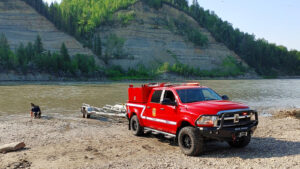Inspiring perseverance are words that can be used to describe Drayton resident Deb Bossert. She has faced obstacles like cancer and immune disorders to start a successful second business in her retirement.
Bossert grew up in Vernon, B.C., but has been part of Drayton this community since 1996. Over the years she has volunteered in many different areas, all with the mission of serving others. Some may recognize her name from her time on town council, others in the faith community will know her from various events she’s participated in. During her time on council she served on many different boards. Bossert was also a volunteer with Humans Helping Humans and currently sits on the board of Burden Bearers.
On top of that Bossert was also a business owner in Drayton Valley. The store Designs By Deb was a bridal boutique that she built from the ground up.
“I’ve been sewing since I was a young girl,” says Bossert, which she says is 45 years of sewing. She is the fourth generation seamstress in her family, and her oldest daughter is the fifth.

Church of God
Service Updates *View website for up to date Covid-19 protocols* Join us Sunday mornings for

Drayton Valley Alliance Church
Join us Sunday Mornings 10:30 am Everyone Welcome! Phone: 780-542-6501 Email: office@dvalliance.ca Mailing address: Box

Valley Worship Assembly
Please take your time and discover what is happening at Valley Worship in Drayton Valley.

Ralcomm Communications
The Ralcomm Group provides communication devices for individuals and businesses. We specialize in technology that

Life Church Drayton Valley
We know that exploring a new church can be an overwhelming experience. To help you
However, life has not been smooth sailing for Bossert. About a year after her youngest daughter was born, Bossert separated from her husband and became a single mother. During that time she sometimes worked a full-time job, but she kept Designs by Deb running.
Designs By Deb was more than just a store for bridal wear. Bossert also offered sewing classes, altered clothing, and spent a fair amount of time repairing coveralls.
In 2009, after hearing encouragement from friends and community members, Bossert decided to run in a by-election for council. She went on to serve as a councillor until 2017.
In 2010, Bossert was diagnosed with aggressive bilateral breast cancer, which led to a double mastectomy as soon as the doctors could arrange it. Four years later, Bossert was diagnosed with a rare immune disorder called common variable immune deficiency.
“I didn’t expect to see 50,” she says and she’s grateful for the eight years she’s had since her diagnosis. “To have survived long enough to meet my grandchildren, and be involved in their lives, and to see where life has taken me has been amazing.”
She did not seek re-election in the municipal elections in 2017. She still worked as much as she could, though she was limited because of her health. However, she lost her job as a teacher for English as Second Language in 2020 when the pandemic hit.
“My health did take quite a decline that spring as well. I was told by my doctors that I needed to retire and just stay home,” says Bossert.
Bossert rarely goes out because her body does not produce antibodies and she has to take an immunoglobulin infusion to keep herself healthy and alive. Any illness she catches could result in hospitalization or death.
There are approximately 187 accidents in town each year within Town limits. That’s according to data from Drayton Valley Enforcement Services.
Cody Rossing, the Manager of Enforcement Services and Emergency Management for the Town, says data from 2016-2023 has helped map out intersections in the community that sees the highest number of collisions. The intersection at 50 Street North and Hwy 22 has had eight collisions, the highest in the community. The second highest number was at the intersection of 50 Street and 50 Avenue.
“Anything along Highway 22, the Town doesn’t have jurisdiction over, pertaining to road designs or changes,” says Rossing.
He says getting the data from the Province regarding collisions along Highway 22 is something they haven’t been able to do before. Now that they have the data they can start mapping out the high incident intersections and starting brainstorming ways they can address some of the problem areas. Rossing says those areas will have more focus from the community peace officers.
Rossing says they are trying to develop strategies on how to reduce collisions in the community on a whole, particularly those that result in fatalities.
“There’s different things we can use like engineering and controls,” says Rossing. “But for enforcement services, how are we strategically educating and enforcing in those areas?”
He says there are a number of factors that can contribute to collisions. Over the past eight years there have been 434 caused from unsafe speeds, 245 were intersection related, 163 that are weather related, 114 from road surface conditions, 51 involving animals, and 417 were from drivers performing improper actions.
With speed being the most prominent cause, enforcement services have been taking action to find out where speeding is most common and increasing patrols. The digital speed signs that were purchased with funds from the Community Safety Committee don’t have cameras on them, but they do record the speed and report that data back to enforcement services.
On March 6, officers intercepted a vehicle driving 102 km per hour in a 50 km zone.
“That vehicle was pulled over, a court summons was issued to the driver to compel them to court. If they don’t attend court a warrant will be issued for them,” says Rossing.
If they are found guilty, they could face a fine of up to $2,000 and/or a license suspension.
Rossing says anyone who is over the speed limit by more than 51 km per hour will face an automatic court summons.
This was not the only incident of speeding. On March 5, the digital speed signs picked up on a vehicle driving 111 km per hour in a 60 km per hour zone. They also pulled over a vehicle going 50 km per hour over the limit that same day.
“That is strictly within the Town of Drayton Valley boundaries,” says Rossing.
There are a number of reports enforcement services can get from the digital signs, including the amount of traffic on a road and the times that see the most traffic. Using this data, enforcement services can ensure they deploy units during the busiest times of the day to the areas where speeding is common.
What you see is what you get
Like William Shatner, Mike Myers, Wayne Gretzky’s dad and God help us, Celine Dion, here at the Free Press, we are Canadian.
There’s been a lot of talk recently about US ownership of some of this country’s most prominent businesses and institutions. At the Free Press we are certainly not prominent, nor do we want to be institutionalized. But still, it seems like a good time to point out to anyone who’s interested, that we are exactly what we appear to be.
We are 100 percent locally owned. There are no hidden shareholders or outside interests. All of our staff live in either Drayton Valley or Brazeau County, apart from our designer, Brittany. She’s from here, but currently telecommutes from somewhere in British Columbia, which I have to confess, makes me a little jealous sometimes.
What else can I tell you? The Free Press is printed for us by some nice people in St. Albert. The printing press is owned by Great West Newspapers, which is also a Canadian company.
The paper we’re printed on comes from the Alberta Newsprint Corporation in Whitecourt. Incidentally, the paper is made from offcuts and waste from the lumber industry so we’re not cutting down trees to make the paper.
Once the paper has been printed it’s picked up and brought back to town by Drayton Valley’s own Rocket Express. At that point it’s back to us as we deliver it throughout the community.
Now you may be wondering why I’m telling you all this. Would the Americans really be interested in owning a tiny little paper in a small town in Alberta?
Well, you’d be surprised. A good chunk of Canada’s print media is currently in American hands, and that includes a number of community newspapers in this province. Postmedia is 66 percent owned by Chatham Asset Management, a hedge fund based in New Jersey. Who are Postmedia? They are the owners of the National Post, the Calgary Herald, the Edmonton Journal, the Calgary Sun, the Edmonton Sun and a host of other newspapers, both large and small, from coast to coast.
That situation may not be quite as bad as it sounds. I was the editor of the Drayton Valley Western Review (kids, ask your grandparents) for 10 years. During my time there the paper was owned by a succession of large, soulless corporations based in central Canada. They did absolutely nothing to impact the way we covered the news. I barely heard a peep in over a decade. I always suspected that was less to do with high journalistic standards at corporate headquarters, and more down to the fact they were only dimly aware we existed and probably couldn’t find Drayton Valley on a map, but either way the effect was the same.
So corporate ownership, whether it’s American or not, probably isn’t the best thing ever, but it isn’t necessarily fatal to Canadian news.
But I do think there’s an important distinction between a paper like the Free Press and some of the others; and it’s this. If you take out a subscription or buy an advertisement with us you can be confident that your money is staying close to home. And especially these days, that seems like a good investment.
Local auctioneer takes the championship
A local auctioneer has chanted his way into the history books after securing himself a first place position at the 2025 Canadian All Around Auctioneer Championship.
Prior to the 2025 CAAAC, Justin Mayer had already earned a trophy at the 2020 Canadian Bid Catching Competition. He is the first to hold a title for both competitions.
Mayer, at 29-years-old, says he’s been participating in the CAAAC for more than a decade. His mentors and many of the auctioneers he grew up listening to have all competed in the competition and some have won.
“It’s a pretty prestigious award,” says Mayer.
A good auctioneer is someone who can present themselves in a professional manner, with confidence in your body language and hand gestures. They have to be well spoken and comfortable with public speaking. The auctioneer chant, which requires rhythm, clarity, and speed to be considered such, is also an important technique that auctioneers must master.
“You should be able to almost dance to an auctioneer’s chant,” says Mayer
When he entered the CAAAC, Mayer participated in two rounds. The preliminary round ruled out everyone except for the top five. Those five then moved onto the final round.
In both rounds, five judges ranked their skills on a scorecard, and the person with the best overall ranking took home the award.
Mayer is not the first member of his family to take home the CAAAC title. His uncle Ron Sekura also held the title, and for Mayer, that makes the win even sweeter.
“He’s passed on, so it’s pretty cool for me to have the title with him,” says Mayer.
As a kid, Mayer was surrounded by some of his biggest mentors in the auctioneering world. His uncle, stepfather Corey Sekura, and grandfather, Wendell Sekura, all encouraged his love of auctioning.
He says he loves the sport because of the high energy atmosphere and the chance to meet people.
“When you’re up on the stand in front of the crowd selling, it’s up to me to present, in lots of cases, people’s livelihoods and their entire life, whether you’re selling a farm or a disbursement sale. It’s up to you, as the auctioneer, to generate excitement and do your homework in front of the crowd in order to bring top dollar for people,” says Mayer.
Over the years, Mayer has met many people and he says he enjoys the connections
“I know somebody from every town,” he says.
Now that he’s taken the title for the CAAAC, he is eligible for the International All Around Auctioneer Championship and from there he can head off to the World Championship.
For many, the decision to go to the international championship would be easy, but Mayer says he’s not sure what he’s going to do.
“I grew up in an auction family, and for me and my family to win this competition was a big deal,” says Mayer. “Now that I’ve won it, I kind of feel like I achieved what I wanted.”
However, Mayer has been receiving encouragement from Rob Bergevin, a Canadian International and Worlds competitor, to go to the International Championship.
“I beat him this year and he’s really trying to convince me to go to the International because he thinks I have a shot at it,” says Mayer.
Mayer’s love of auctioneering resulted in him going to Western College of Auctioneering in Billings, Montana in 2013. Since then, he’s been building up his reputation as an auctioneer across Alberta and British Columbia.
He says his uncle and stepfather were always in his ear, pointing out areas where he could do better and giving him advice to improve his skill.
“Grandpa Wendy was a big factor in that as well,” says Mayer.
For several years, Mayer spent a lot of time travelling to municipalities across the province and British Columbia to local auctions. However, once the pandemic hit, many auction houses opted for online auctions as a way to still run the business while meeting government regulations. Since that time, it’s not uncommon for auctions to be held online.
“But I still travel around,” says Mayer. “I still do lots of auctions. I’m never going to stop. It’s too exciting.”
Over the years, Mayer has worked for Team Auctions, as well as auctioning off classic cars. He also works for a lot of charity auctions.
When his children were younger, they struggled with the amount of time that Mayer was away. Now that they’re older, he says they appreciate it more. His daughter has even been asking for lessons, and has been practicing reading off a list of numbers that she has on her wall.
Mayer says he’s grateful to everyone for their support and encouragement over the years.
“I’m tremendously thankful to my mom, my dad, the Sekura family, my wife and my kids. They have all been there for me. They’ve all shaped me,” says Mayer. “Probably my biggest influence in all of it was my Uncle Ron, and my dad, Corey. They really shaped me and supported me.”
Charter school proposal moving forward
Members of local indigenous groups are working toward opening a charter school with the goal of offering students an education that goes beyond academics.
Charlene Bearhead, a member of the board for the Roots of Resilience not-for-profit society, says the group is applying to the Minister of Education to be able to open a charter school in Drayton Valley, with a goal of opening in September.
The society is hosting an information night on February 13 from 5-7:30 p.m. at the Holiday Inn Express.
Bearhead says her 40 years of working in education has made it clear that the system is failing children and staff as human beings.
“I’m always a big believer in doing the best you can to try to work with what exists already and do what you can to help guide that,” says Bearhead.
She worked within the system, and recently served as a school board trustee, but she says people weren’t ready to progress with changes she feels need to be made.
The goal of opening the charter school is to offer a learning experience that encompasses a child’s entire wellbeing, including mental and spiritual health, along with teaching Alberta’s curriculum. While the students will learn from methods that indigenous people have always used for passing on knowledge, Bearhead says the school isn’t just open to indigenous children. Any child in the area from Kindergarten to grade 12 will be welcome to attend.
One thing that Bearhead wants the public to be aware of regarding charter schools is that they are still public schools. Roots of Resilience will be funded in the same manner that Wild Rose School Division and the St. Thomas Aquinas Roman Catholic School Division are.
“One lady said to me, ‘This sounds so amazing Charlene, but I really struggle with anything that takes away from public schools,’” says Bearhead. “I had to say to her ‘This is public education. This is public school.’”
She says there are only provisions for charter schools in Alberta. Charter schools receive the same funding for facilities, transportations, and other expenses, and the same requirements to follow the Alberta curriculum and the Education Act. Just like any other public school, parents do not have to pay extra to enrol their children in a charter school.
“But they are intended to be schools of choice,” says Bearhead. “They give parents and kids a choice in their education.”
However, charter schools are not without controversy. According to the website of Alberta Teachers’ Association, “there is only one pot of money for schools in Alberta. When money is diverted to private and charter schools, it leaves public schools in a funding shortfall.”
Bearhead says charter schools have to offer a unique approach to education that isn’t available in the geographic area. Bearhead says it’s important to the RoR society to define the holistic success for the school, which means the students will be doing better in body, mind, and soul, as well as academically.
She says that pushing people hard to do well academically while ignoring all other aspects of the student’s progress doesn’t work well. For Bearhead, it’s important for educators to meet the students where they’re at, value them as human beings, offer them a safe environment, and offer opportunities for the students to see themselves reflected in what is being taught.
Along with the regular curriculum, Bearhead says they plan to offer language programs for those who are interested in learning the language of their ancestors to help those students connect with their heritage.
Wendy Snow, the Interim District Captain in the Otipemisiwak Metis Government for District Eight and member of the RoR society, says she feels her own children would have benefitted from what the proposed school will be offering.
Snow says she has two children as well as a niece that she is the guardian of. With all three of them going to school in Drayton, she says they went to almost every school in the community.
“I found that it was very lacking as far as teaching to our culture,” says Snow.
She says every year she would fill out the demographic forms, indicating that her children were indigenous, knowing that the school division would get additional funding for those students.
“I found that all of the funding in the Wild Rose School Division went to Rocky Mountain House,” she says. “All the programming, all the culture stuff, everything went to Rocky Mountain House.”
Like Bearhead, Snow wanted to work with the system and try to help improve things. She ran twice for school board trustee, but did not get elected.
“I’ve always wanted to see more funding and programming and culture stuff in this area, just like there is in Rocky Mountain House,” says Snow.
Bearhead says the RoR school will resonate with indigenous children.
“An indigenous pedagogy, or approach to education, is about physical, mental, social, emotional, and spiritual [well-being]. Whatever that means to you. Everyone is indigenous to somewhere,” says Bearhead.
She says public charter schools are smaller and have unique approaches to education.
“They are actually intended to be models for how education could happen in any or all public schools,” she says.
Bearhead says when the students see themselves reflected in the content they’re learning, they have a better chance of relating to it and absorbing it.
By making the students the centre of the system, educators can focus on the whole child, not just the content they’re supposed to be learning. She says each student has different strengths, weaknesses, interests, and paths. In their school, they plan to help students excel at their strengths, offer support for their weaknesses, and encourage their interests and plans.
Another important part of education is offering the students a safe space.
“If kids are terrified, if kids are being bullied, if kids don’t feel safe, how can they focus on learning?” says Bearhead. “That’s just human instinct. That’s survival.”
She says if students are feeling ostracized, alienated, or left out, it’s more challenging for them to learn.
Roots of Resilience will also offer hands-on learning for students. This experiential learning will be land-based, which means there will be more of a balance between indoor and outdoor learning. She says there are many different areas of the curriculum that can be taught outdoors beyond science and physical education.
“For me, when you do something, rather than just read about it or hear about it, it becomes ingrained in you,” she says.
Snow says she wants to see children in the area have an opportunity to choose an education that best suits them.
“I think it just gives them a great basis for success later on in life,” says Snow.
Learning About the Newspaper
Grade 4: Let's learn about the Newspaper
Introduction
My name is Mrs. Brandy Fredrickson (I am Ruth’s mom) and I own the Drayton Valley and District Free Press newspaper. I used to be a reporter a the Drayton Valley Western Review…20 years ago. In this job I met some amazing people and learned so much about my community. My co-workers from 20 years ago are now my staff and we still have a lot of fun writing about Drayton Valley.
Question: What is one thing (person, place, team) that makes Drayton Valley a special place for you?
What is a newspaper?
A newspaper is a collection of stories, photos, advertisements, columns and letters that represent the collective news and mood of your community at a given point in time.
Types of Newspaper
National Newspapers: National Post, Globe and Mail
Provincial Newspapers: Edmonton Journals, Calgary Herald
Regional/Local Newspapers: That Us! Often these papers are locally owned, family started and some are 60-100 years old.
Other Regional:
Activity 1: Get to know the newspaper
Activity: Seek and Find
What you need: 1 piece of paper, 1 pencil, 1 Free Press Newspaper
- Get into groups of 4
- On a piece of paper write down numbers 1-5
- Find these 5 things in the paper
- Bring your answers up to me and shake my hand when you’re done
- Two Fastest teams get a treat

And Go....
- What is the tagline under the “Free Press” masthead on pg. 1?
- Who wrote the letter about the ski hill (name)?
- Who took the photo on pg. 11?
- Name one business in the business directory?
- Who is the editor of newspaper (name)?
Layout Discussion:
How is a paper the same as a magazine? How is the newspaper different than a book?
Getting in front of eyeballs: How is the newspaper distributed?
Making sure the newspaper is seen is a big part of having a local newspaper. Distribution channels helps to make this happen. The Free Press has 3 distribution channels.
1. Email Subscriptions
2. Canada Post mail subscriptions
3. Free pickup in retail locations
Discussion:
How does your teacher share information with you? And how do you share information with your parents?
Activity: Watch Video of the printing press
Fact Checking and Credibility
“Thou shalt not lie.”
Discussion: Why do you think it is important not to lie?
Credibility is the foundation of any newspaper. If your readers cannot trust what you are writing you won’t have an audience for long. This is why our editor spend much of his time fact checking, and rechecking facts in the stories we publish.
Activity 2: Is it True?
In your groups look at your newspaper and tell me if this headline is true.
Is this headline true?
- Town Council passes interim budget
- Volunteer database up and running
- Town billing changed despite strike
Activity 3: Examine a story
Mrs. Fredrickson Read: “Councillor Responds to Allegations”
What are some facts in this story that would need to be checked?
Activity 4: "Telephone " fact checking
- Get into 2 long lines
- Teacher select 2 people to be “fact checkers”
- Beginning at the start whisper message into your neighbours ear, and continue down the line.
- Once the message gets to a fact checker, the fact checker will give a thumbs up to continue telephone if the message is correct or go back to the start of the line to restart the telephone if the message is incorrect.
Here are some sources we use to check facts:
Call people to confirm information
Voice record interviews
Use multiple sources
Discussion
What ways can you check the facts for school projects or school gossip?
Jobs at a newspaper
Running a newspaper requires a team. Each person contributes to the success of the paper. Below are some jobs that people have to making a successful local newspaper.








Activity 5: Who does what?
In groups of 4 go to and PAGE 9 of the newspaper and label who did what.
E = Editor
R = Reporter
GD = Graphic Designer
C = Columnist
S = Sales
Activity 6: Conducting an Interview Speed Style
Interviewing people is a major job of a newspaper reporter. To conduct a good interview you need these three elements:
1. Questions; open ended
2. Paper and pen, or recorder
3. Listening ears and eyes
Open Ended Questions
Open ended questions are questions that get people talking. The are not yes or no questions. They are “How,” “Who,” and “What” questions.
Example: How did you feel winning the basketball game? What inspired you to write that story?
Recording Tool
Never go to a newspaper interview without a recording device; Paper, pen, voice recorder or texting device. Reporters often quote and paraphrase their subjects and accuracy is key.
Quote: “I love to teach,” Kormysh said.
Paraphrase: Kormysh said she loves teahing.
Active listening
Active listening means you are listening with your ears (close your mouth), your eyes and your body language. The key to a good interview is to get the other person talking this means you have to stop talking.
Speed Interview Game
1. Take out a piece of paper.
2. Write down 1 open ended question you can ask a classmates
4. When I say go, find a classmate and ask your question. Listen.
5. Record their answer.
6. Find someone new when I say “Switch”
7. Discussion: Report on what you learned? How accurate was your reporting?
Final Activity 7: Photo and Feedback
Take the handout and answer the following question.
A. What is one thing I learned about the newspaper?
B. Gather for a Group Photo
Mental health calls drain resources
Police in Drayton Valley have seen an increase in the last year of arrests made under the Mental Health Act. Earlier this month Staff Sergeant Ryan Hoetmer told town council that calls of that type have seen a steady increase over the past several years, and they remain a big drain on resources for the Town.
Hoetmer explained that when the officers take somebody into custody under the act, they then take that person to the Centennial Centre for Mental Health in Ponoka. He says the drive itself eats up several hours of the officer’s time, but they also have to wait until staff at the centre take over.
He said the Centennial Centre has been working to make the intake process more efficient. In the past, officers have had to wait a couple of hours. Now, he says they make a call when they are on their way, and usually the intake is complete within half an hour.
When asked how long people are kept at the hospital, Hoetmer explained that they were normally kept for a week or two. At most, he believes they might be kept for a month.
Many of their calls under the Mental Health Act are from people the RCMP are already aware of, and Hoetmer says it can be a challenge keeping on top of those cases.
He says the RCMP bring the subject into the hospital. Once they are deemed healthy enough to depart, the person is often sent back to their community in a cab. After that, the individuals are in the same position they were in prior to the process beginning.
“I’m a big believer that there’s a bit of a gap there,” said Hoetmer. “When they are sent in a cab back to Drayton, they’re put back into the same position as before. There is no follow up program or some place for them to go in between.”
He said often RCMP watch the individuals as their mental health slowly declines until they have the grounds to apprehend them again.
Councillor Amila Gammana asked Hoetmer if he felt the reason people were being released on such a short timeline was due to a lack of resources. Hoetmer said he wasn’t sure what the reason for it was and that Alberta Health Services would better be able to answer that.
“I would hope it’s not a resourcing concern, that when the doctor is making their determination they are healthy enough to leave the facility,” he said. “But they have pressures, I’m sure, just like everybody else.”
Mayor Nancy Dodds asked Hoetmer if he’d seen an increase in resources since the new pillar ministries had been put into place, but Hoetmer says thus far they haven’t seen a change.
“We still have our one [Regional Police and Crisis Team] that operates out of Rocky, but as I’ve talked about before they are in our community maybe once a week,” said Hoetmer.
This means if there is an emergent issue that requires a response, the RPACT are not the ones who are responding to the call. It is instead left to the members of the Drayton Valley detachment.
“They do lots of follow up for us, but it’s our members that are doing the apprehensions and are going to the crisis when it’s happening,” said Hoetmer.
“I don’t like to dwell on the limitations of my medical condition. I’ve learned to be very content and very happy at home,” she says.
When the pandemic broke out, Bossert hardly left the house. Determined not to give in to the loneliness and depression that can come with long-term self-isolation, Bossert turned to painting and calligraphy as an outlet.
Bossert says in many ways she’s reinvented herself over the years. “From administrator to town councillor to teacher and to script and copy editor and calligrapher and artist, and now I’ve come back to my sewing.”
She says she was surprised to realize she had any talent as an artist, because she had never done it efore. By selling the water colour cards she was making, Bossert was able to bring in a little money, but nothing major.
It wasn’t until one of her friends, who became a partner in her new business venture, requested a favour from Bossert that she was able to bring in full-time income.
In mid-October 2021, Bossert’s friend came to her with a request for a riding skirt. Her friend had one, but wanted another, and Bossert was happy to help. She first made a prototype to ensure she got it right, and then she built her friend’s skirt.
At the Home Expo at the MacKenzie Centre in late November, Bossert displayed the skirts she had made. From there her business has exploded.
“It just went crazy from there. Within the first month we had 26 orders,” says Bossert.
Since December, when Bossert first started pursuing this new niche market of historical equestrian wear, she has had almost 60 orders. These have been delivered to 14 states in America, and one was purchased by someone from Switzerland via a sibling in Canada.
“Only about ten percent of my clients are from Alberta,” she says.
She says word has spread through social media, and she hasn’t had to do any advertising. If she posts a picture of a new product, she says she gets even more orders. To allow her to catch up, Bossert says she’s been radio silent on social media for a couple of weeks.
“As soon as I launch stuff, then boom, I get even more orders,” says Bossert.
While the business is a success, it’s been a lot of work in a short period of time. After 30 years, she has decided to retire Designs By Deb, and has now rebranded her business as The Creative Daughter. This has meant ordering new signs, creating a logo, new labels for her products, and finding the space to make it all happen.
There are approximately 187 accidents in town each year within Town limits. That’s according to data from Drayton Valley Enforcement Services.
Cody Rossing, the Manager of Enforcement Services and Emergency Management for the Town, says data from 2016-2023 has helped map out intersections in the community that sees the highest number of collisions. The intersection at 50 Street North and Hwy 22 has had eight collisions, the highest in the community. The second highest number was at the intersection of 50 Street and 50 Avenue.
“Anything along Highway 22, the Town doesn’t have jurisdiction over, pertaining to road designs or changes,” says Rossing.
He says getting the data from the Province regarding collisions along Highway 22 is something they haven’t been able to do before. Now that they have the data they can start mapping out the high incident intersections and starting brainstorming ways they can address some of the problem areas. Rossing says those areas will have more focus from the community peace officers.
Rossing says they are trying to develop strategies on how to reduce collisions in the community on a whole, particularly those that result in fatalities.
“There’s different things we can use like engineering and controls,” says Rossing. “But for enforcement services, how are we strategically educating and enforcing in those areas?”
He says there are a number of factors that can contribute to collisions. Over the past eight years there have been 434 caused from unsafe speeds, 245 were intersection related, 163 that are weather related, 114 from road surface conditions, 51 involving animals, and 417 were from drivers performing improper actions.
With speed being the most prominent cause, enforcement services have been taking action to find out where speeding is most common and increasing patrols. The digital speed signs that were purchased with funds from the Community Safety Committee don’t have cameras on them, but they do record the speed and report that data back to enforcement services.
On March 6, officers intercepted a vehicle driving 102 km per hour in a 50 km zone.
“That vehicle was pulled over, a court summons was issued to the driver to compel them to court. If they don’t attend court a warrant will be issued for them,” says Rossing.
If they are found guilty, they could face a fine of up to $2,000 and/or a license suspension.
Rossing says anyone who is over the speed limit by more than 51 km per hour will face an automatic court summons.
This was not the only incident of speeding. On March 5, the digital speed signs picked up on a vehicle driving 111 km per hour in a 60 km per hour zone. They also pulled over a vehicle going 50 km per hour over the limit that same day.
“That is strictly within the Town of Drayton Valley boundaries,” says Rossing.
There are a number of reports enforcement services can get from the digital signs, including the amount of traffic on a road and the times that see the most traffic. Using this data, enforcement services can ensure they deploy units during the busiest times of the day to the areas where speeding is common.
Like William Shatner, Mike Myers, Wayne Gretzky’s dad and God help us, Celine Dion, here at the Free Press, we are Canadian.
There’s been a lot of talk recently about US ownership of some of this country’s most prominent businesses and institutions. At the Free Press we are certainly not prominent, nor do we want to be institutionalized. But still, it seems like a good time to point out to anyone who’s interested, that we are exactly what we appear to be.
We are 100 percent locally owned. There are no hidden shareholders or outside interests. All of our staff live in either Drayton Valley or Brazeau County, apart from our designer, Brittany. She’s from here, but currently telecommutes from somewhere in British Columbia, which I have to confess, makes me a little jealous sometimes.
What else can I tell you? The Free Press is printed for us by some nice people in St. Albert. The printing press is owned by Great West Newspapers, which is also a Canadian company.
The paper we’re printed on comes from the Alberta Newsprint Corporation in Whitecourt. Incidentally, the paper is made from offcuts and waste from the lumber industry so we’re not cutting down trees to make the paper.
Once the paper has been printed it’s picked up and brought back to town by Drayton Valley’s own Rocket Express. At that point it’s back to us as we deliver it throughout the community.
Now you may be wondering why I’m telling you all this. Would the Americans really be interested in owning a tiny little paper in a small town in Alberta?
Well, you’d be surprised. A good chunk of Canada’s print media is currently in American hands, and that includes a number of community newspapers in this province. Postmedia is 66 percent owned by Chatham Asset Management, a hedge fund based in New Jersey. Who are Postmedia? They are the owners of the National Post, the Calgary Herald, the Edmonton Journal, the Calgary Sun, the Edmonton Sun and a host of other newspapers, both large and small, from coast to coast.
That situation may not be quite as bad as it sounds. I was the editor of the Drayton Valley Western Review (kids, ask your grandparents) for 10 years. During my time there the paper was owned by a succession of large, soulless corporations based in central Canada. They did absolutely nothing to impact the way we covered the news. I barely heard a peep in over a decade. I always suspected that was less to do with high journalistic standards at corporate headquarters, and more down to the fact they were only dimly aware we existed and probably couldn’t find Drayton Valley on a map, but either way the effect was the same.
So corporate ownership, whether it’s American or not, probably isn’t the best thing ever, but it isn’t necessarily fatal to Canadian news.
But I do think there’s an important distinction between a paper like the Free Press and some of the others; and it’s this. If you take out a subscription or buy an advertisement with us you can be confident that your money is staying close to home. And especially these days, that seems like a good investment.
A local auctioneer has chanted his way into the history books after securing himself a first place position at the 2025 Canadian All Around Auctioneer Championship.
Prior to the 2025 CAAAC, Justin Mayer had already earned a trophy at the 2020 Canadian Bid Catching Competition. He is the first to hold a title for both competitions.
Mayer, at 29-years-old, says he’s been participating in the CAAAC for more than a decade. His mentors and many of the auctioneers he grew up listening to have all competed in the competition and some have won.
“It’s a pretty prestigious award,” says Mayer.
A good auctioneer is someone who can present themselves in a professional manner, with confidence in your body language and hand gestures. They have to be well spoken and comfortable with public speaking. The auctioneer chant, which requires rhythm, clarity, and speed to be considered such, is also an important technique that auctioneers must master.
“You should be able to almost dance to an auctioneer’s chant,” says Mayer
When he entered the CAAAC, Mayer participated in two rounds. The preliminary round ruled out everyone except for the top five. Those five then moved onto the final round.
In both rounds, five judges ranked their skills on a scorecard, and the person with the best overall ranking took home the award.
Mayer is not the first member of his family to take home the CAAAC title. His uncle Ron Sekura also held the title, and for Mayer, that makes the win even sweeter.
“He’s passed on, so it’s pretty cool for me to have the title with him,” says Mayer.
As a kid, Mayer was surrounded by some of his biggest mentors in the auctioneering world. His uncle, stepfather Corey Sekura, and grandfather, Wendell Sekura, all encouraged his love of auctioning.
He says he loves the sport because of the high energy atmosphere and the chance to meet people.
“When you’re up on the stand in front of the crowd selling, it’s up to me to present, in lots of cases, people’s livelihoods and their entire life, whether you’re selling a farm or a disbursement sale. It’s up to you, as the auctioneer, to generate excitement and do your homework in front of the crowd in order to bring top dollar for people,” says Mayer.
Over the years, Mayer has met many people and he says he enjoys the connections
“I know somebody from every town,” he says.
Now that he’s taken the title for the CAAAC, he is eligible for the International All Around Auctioneer Championship and from there he can head off to the World Championship.
For many, the decision to go to the international championship would be easy, but Mayer says he’s not sure what he’s going to do.
“I grew up in an auction family, and for me and my family to win this competition was a big deal,” says Mayer. “Now that I’ve won it, I kind of feel like I achieved what I wanted.”
However, Mayer has been receiving encouragement from Rob Bergevin, a Canadian International and Worlds competitor, to go to the International Championship.
“I beat him this year and he’s really trying to convince me to go to the International because he thinks I have a shot at it,” says Mayer.
Mayer’s love of auctioneering resulted in him going to Western College of Auctioneering in Billings, Montana in 2013. Since then, he’s been building up his reputation as an auctioneer across Alberta and British Columbia.
He says his uncle and stepfather were always in his ear, pointing out areas where he could do better and giving him advice to improve his skill.
“Grandpa Wendy was a big factor in that as well,” says Mayer.
For several years, Mayer spent a lot of time travelling to municipalities across the province and British Columbia to local auctions. However, once the pandemic hit, many auction houses opted for online auctions as a way to still run the business while meeting government regulations. Since that time, it’s not uncommon for auctions to be held online.
“But I still travel around,” says Mayer. “I still do lots of auctions. I’m never going to stop. It’s too exciting.”
Over the years, Mayer has worked for Team Auctions, as well as auctioning off classic cars. He also works for a lot of charity auctions.
When his children were younger, they struggled with the amount of time that Mayer was away. Now that they’re older, he says they appreciate it more. His daughter has even been asking for lessons, and has been practicing reading off a list of numbers that she has on her wall.
Mayer says he’s grateful to everyone for their support and encouragement over the years.
“I’m tremendously thankful to my mom, my dad, the Sekura family, my wife and my kids. They have all been there for me. They’ve all shaped me,” says Mayer. “Probably my biggest influence in all of it was my Uncle Ron, and my dad, Corey. They really shaped me and supported me.”
Members of local indigenous groups are working toward opening a charter school with the goal of offering students an education that goes beyond academics.
Charlene Bearhead, a member of the board for the Roots of Resilience not-for-profit society, says the group is applying to the Minister of Education to be able to open a charter school in Drayton Valley, with a goal of opening in September.
The society is hosting an information night on February 13 from 5-7:30 p.m. at the Holiday Inn Express.
Bearhead says her 40 years of working in education has made it clear that the system is failing children and staff as human beings.
“I’m always a big believer in doing the best you can to try to work with what exists already and do what you can to help guide that,” says Bearhead.
She worked within the system, and recently served as a school board trustee, but she says people weren’t ready to progress with changes she feels need to be made.
The goal of opening the charter school is to offer a learning experience that encompasses a child’s entire wellbeing, including mental and spiritual health, along with teaching Alberta’s curriculum. While the students will learn from methods that indigenous people have always used for passing on knowledge, Bearhead says the school isn’t just open to indigenous children. Any child in the area from Kindergarten to grade 12 will be welcome to attend.
One thing that Bearhead wants the public to be aware of regarding charter schools is that they are still public schools. Roots of Resilience will be funded in the same manner that Wild Rose School Division and the St. Thomas Aquinas Roman Catholic School Division are.
“One lady said to me, ‘This sounds so amazing Charlene, but I really struggle with anything that takes away from public schools,’” says Bearhead. “I had to say to her ‘This is public education. This is public school.’”
She says there are only provisions for charter schools in Alberta. Charter schools receive the same funding for facilities, transportations, and other expenses, and the same requirements to follow the Alberta curriculum and the Education Act. Just like any other public school, parents do not have to pay extra to enrol their children in a charter school.
“But they are intended to be schools of choice,” says Bearhead. “They give parents and kids a choice in their education.”
However, charter schools are not without controversy. According to the website of Alberta Teachers’ Association, “there is only one pot of money for schools in Alberta. When money is diverted to private and charter schools, it leaves public schools in a funding shortfall.”
Bearhead says charter schools have to offer a unique approach to education that isn’t available in the geographic area. Bearhead says it’s important to the RoR society to define the holistic success for the school, which means the students will be doing better in body, mind, and soul, as well as academically.
She says that pushing people hard to do well academically while ignoring all other aspects of the student’s progress doesn’t work well. For Bearhead, it’s important for educators to meet the students where they’re at, value them as human beings, offer them a safe environment, and offer opportunities for the students to see themselves reflected in what is being taught.
Along with the regular curriculum, Bearhead says they plan to offer language programs for those who are interested in learning the language of their ancestors to help those students connect with their heritage.
Wendy Snow, the Interim District Captain in the Otipemisiwak Metis Government for District Eight and member of the RoR society, says she feels her own children would have benefitted from what the proposed school will be offering.
Snow says she has two children as well as a niece that she is the guardian of. With all three of them going to school in Drayton, she says they went to almost every school in the community.
“I found that it was very lacking as far as teaching to our culture,” says Snow.
She says every year she would fill out the demographic forms, indicating that her children were indigenous, knowing that the school division would get additional funding for those students.
“I found that all of the funding in the Wild Rose School Division went to Rocky Mountain House,” she says. “All the programming, all the culture stuff, everything went to Rocky Mountain House.”
Like Bearhead, Snow wanted to work with the system and try to help improve things. She ran twice for school board trustee, but did not get elected.
“I’ve always wanted to see more funding and programming and culture stuff in this area, just like there is in Rocky Mountain House,” says Snow.
Bearhead says the RoR school will resonate with indigenous children.
“An indigenous pedagogy, or approach to education, is about physical, mental, social, emotional, and spiritual [well-being]. Whatever that means to you. Everyone is indigenous to somewhere,” says Bearhead.
She says public charter schools are smaller and have unique approaches to education.
“They are actually intended to be models for how education could happen in any or all public schools,” she says.
Bearhead says when the students see themselves reflected in the content they’re learning, they have a better chance of relating to it and absorbing it.
By making the students the centre of the system, educators can focus on the whole child, not just the content they’re supposed to be learning. She says each student has different strengths, weaknesses, interests, and paths. In their school, they plan to help students excel at their strengths, offer support for their weaknesses, and encourage their interests and plans.
Another important part of education is offering the students a safe space.
“If kids are terrified, if kids are being bullied, if kids don’t feel safe, how can they focus on learning?” says Bearhead. “That’s just human instinct. That’s survival.”
She says if students are feeling ostracized, alienated, or left out, it’s more challenging for them to learn.
Roots of Resilience will also offer hands-on learning for students. This experiential learning will be land-based, which means there will be more of a balance between indoor and outdoor learning. She says there are many different areas of the curriculum that can be taught outdoors beyond science and physical education.
“For me, when you do something, rather than just read about it or hear about it, it becomes ingrained in you,” she says.
Snow says she wants to see children in the area have an opportunity to choose an education that best suits them.
“I think it just gives them a great basis for success later on in life,” says Snow.
Grade 4: Let's learn about the Newspaper
Introduction
My name is Mrs. Brandy Fredrickson (I am Ruth’s mom) and I own the Drayton Valley and District Free Press newspaper. I used to be a reporter a the Drayton Valley Western Review…20 years ago. In this job I met some amazing people and learned so much about my community. My co-workers from 20 years ago are now my staff and we still have a lot of fun writing about Drayton Valley.
Question: What is one thing (person, place, team) that makes Drayton Valley a special place for you?
What is a newspaper?
A newspaper is a collection of stories, photos, advertisements, columns and letters that represent the collective news and mood of your community at a given point in time.
Types of Newspaper
National Newspapers: National Post, Globe and Mail
Provincial Newspapers: Edmonton Journals, Calgary Herald
Regional/Local Newspapers: That Us! Often these papers are locally owned, family started and some are 60-100 years old.
Other Regional:
Activity 1: Get to know the newspaper
Activity: Seek and Find
What you need: 1 piece of paper, 1 pencil, 1 Free Press Newspaper
- Get into groups of 4
- On a piece of paper write down numbers 1-5
- Find these 5 things in the paper
- Bring your answers up to me and shake my hand when you’re done
- Two Fastest teams get a treat

And Go....
- What is the tagline under the “Free Press” masthead on pg. 1?
- Who wrote the letter about the ski hill (name)?
- Who took the photo on pg. 11?
- Name one business in the business directory?
- Who is the editor of newspaper (name)?
Layout Discussion:
How is a paper the same as a magazine? How is the newspaper different than a book?
Getting in front of eyeballs: How is the newspaper distributed?
Making sure the newspaper is seen is a big part of having a local newspaper. Distribution channels helps to make this happen. The Free Press has 3 distribution channels.
1. Email Subscriptions
2. Canada Post mail subscriptions
3. Free pickup in retail locations
Discussion:
How does your teacher share information with you? And how do you share information with your parents?
Activity: Watch Video of the printing press
Fact Checking and Credibility
“Thou shalt not lie.”
Discussion: Why do you think it is important not to lie?
Credibility is the foundation of any newspaper. If your readers cannot trust what you are writing you won’t have an audience for long. This is why our editor spend much of his time fact checking, and rechecking facts in the stories we publish.
Activity 2: Is it True?
In your groups look at your newspaper and tell me if this headline is true.
Is this headline true?
- Town Council passes interim budget
- Volunteer database up and running
- Town billing changed despite strike
Activity 3: Examine a story
Mrs. Fredrickson Read: “Councillor Responds to Allegations”
What are some facts in this story that would need to be checked?
Activity 4: "Telephone " fact checking
- Get into 2 long lines
- Teacher select 2 people to be “fact checkers”
- Beginning at the start whisper message into your neighbours ear, and continue down the line.
- Once the message gets to a fact checker, the fact checker will give a thumbs up to continue telephone if the message is correct or go back to the start of the line to restart the telephone if the message is incorrect.
Here are some sources we use to check facts:
Call people to confirm information
Voice record interviews
Use multiple sources
Discussion
What ways can you check the facts for school projects or school gossip?
Jobs at a newspaper
Running a newspaper requires a team. Each person contributes to the success of the paper. Below are some jobs that people have to making a successful local newspaper.








Activity 5: Who does what?
In groups of 4 go to and PAGE 9 of the newspaper and label who did what.
E = Editor
R = Reporter
GD = Graphic Designer
C = Columnist
S = Sales
Activity 6: Conducting an Interview Speed Style
Interviewing people is a major job of a newspaper reporter. To conduct a good interview you need these three elements:
1. Questions; open ended
2. Paper and pen, or recorder
3. Listening ears and eyes
Open Ended Questions
Open ended questions are questions that get people talking. The are not yes or no questions. They are “How,” “Who,” and “What” questions.
Example: How did you feel winning the basketball game? What inspired you to write that story?
Recording Tool
Never go to a newspaper interview without a recording device; Paper, pen, voice recorder or texting device. Reporters often quote and paraphrase their subjects and accuracy is key.
Quote: “I love to teach,” Kormysh said.
Paraphrase: Kormysh said she loves teahing.
Active listening
Active listening means you are listening with your ears (close your mouth), your eyes and your body language. The key to a good interview is to get the other person talking this means you have to stop talking.
Speed Interview Game
1. Take out a piece of paper.
2. Write down 1 open ended question you can ask a classmates
4. When I say go, find a classmate and ask your question. Listen.
5. Record their answer.
6. Find someone new when I say “Switch”
7. Discussion: Report on what you learned? How accurate was your reporting?
Final Activity 7: Photo and Feedback
Take the handout and answer the following question.
A. What is one thing I learned about the newspaper?
B. Gather for a Group Photo
Police in Drayton Valley have seen an increase in the last year of arrests made under the Mental Health Act. Earlier this month Staff Sergeant Ryan Hoetmer told town council that calls of that type have seen a steady increase over the past several years, and they remain a big drain on resources for the Town.
Hoetmer explained that when the officers take somebody into custody under the act, they then take that person to the Centennial Centre for Mental Health in Ponoka. He says the drive itself eats up several hours of the officer’s time, but they also have to wait until staff at the centre take over.
He said the Centennial Centre has been working to make the intake process more efficient. In the past, officers have had to wait a couple of hours. Now, he says they make a call when they are on their way, and usually the intake is complete within half an hour.
When asked how long people are kept at the hospital, Hoetmer explained that they were normally kept for a week or two. At most, he believes they might be kept for a month.
Many of their calls under the Mental Health Act are from people the RCMP are already aware of, and Hoetmer says it can be a challenge keeping on top of those cases.
He says the RCMP bring the subject into the hospital. Once they are deemed healthy enough to depart, the person is often sent back to their community in a cab. After that, the individuals are in the same position they were in prior to the process beginning.
“I’m a big believer that there’s a bit of a gap there,” said Hoetmer. “When they are sent in a cab back to Drayton, they’re put back into the same position as before. There is no follow up program or some place for them to go in between.”
He said often RCMP watch the individuals as their mental health slowly declines until they have the grounds to apprehend them again.
Councillor Amila Gammana asked Hoetmer if he felt the reason people were being released on such a short timeline was due to a lack of resources. Hoetmer said he wasn’t sure what the reason for it was and that Alberta Health Services would better be able to answer that.
“I would hope it’s not a resourcing concern, that when the doctor is making their determination they are healthy enough to leave the facility,” he said. “But they have pressures, I’m sure, just like everybody else.”
Mayor Nancy Dodds asked Hoetmer if he’d seen an increase in resources since the new pillar ministries had been put into place, but Hoetmer says thus far they haven’t seen a change.
“We still have our one [Regional Police and Crisis Team] that operates out of Rocky, but as I’ve talked about before they are in our community maybe once a week,” said Hoetmer.
This means if there is an emergent issue that requires a response, the RPACT are not the ones who are responding to the call. It is instead left to the members of the Drayton Valley detachment.
“They do lots of follow up for us, but it’s our members that are doing the apprehensions and are going to the crisis when it’s happening,” said Hoetmer.
During this time, Bossert has also been down with Covid and another illness, which meant she was unable to work for three weeks.
“These last three months have been an amazing journey,” she says.
Bossert is once again sewing full-time and has been able to hire a part-time employee to help her keep up with her orders. Because she can’t leave her house due to her disability, Bossert says she needs to be careful about how many orders she takes on because she only has so much space.
Her spare room is currently her new studio, and she converted her sunroom into an office/spare room. She has a fitting mirror in her living area, and her dining room table is often used for cutting patterns.
She says when she was first building the skirt for her friend, and displaying it at the Expo, she didn’t expect it to really go anywhere. Her business partner, however, knew it would be a roaring success.
Bossert and her partner have stepped into a niche market for equestrian wear. Many of her competitors don’t offer wool skirts with patterns on them. Everything is one colour. Bossert, on the other hand, offers several different patterns of material for her products.
All of her products are reversible. They are wool on the outside, but if a person is out in rainy weather, they can turn the skirt around and expose the nylon lining. The lining allows water to roll right off it. One client even requested some reflective wear on the inside, so Bossert made a skirt with reflective fabric.
“Some of my clients told me they have been looking for a skirt like this for four years,” says Bossert.
One of the perks her clients enjoy with Bossert is all of the items are custom made. This means Bossert can make clothing for any size of person.
She says her business doesn’t just focus on attire for people who are trail riding. Bossert also makes clothing for hunters, mounted archers, and carriage drivers. “Some of it is really specific stuff, so I enjoy it,” she says.
Her daughter, Michelle, used to be a costumer, but has now followed in her mother’s footsteps and designs bridal wear. Bossert now considers herself mainly a costumer. “We’ve kind of switched places,” she says.
There are approximately 187 accidents in town each year within Town limits. That’s according to data from Drayton Valley Enforcement Services.
Cody Rossing, the Manager of Enforcement Services and Emergency Management for the Town, says data from 2016-2023 has helped map out intersections in the community that sees the highest number of collisions. The intersection at 50 Street North and Hwy 22 has had eight collisions, the highest in the community. The second highest number was at the intersection of 50 Street and 50 Avenue.
“Anything along Highway 22, the Town doesn’t have jurisdiction over, pertaining to road designs or changes,” says Rossing.
He says getting the data from the Province regarding collisions along Highway 22 is something they haven’t been able to do before. Now that they have the data they can start mapping out the high incident intersections and starting brainstorming ways they can address some of the problem areas. Rossing says those areas will have more focus from the community peace officers.
Rossing says they are trying to develop strategies on how to reduce collisions in the community on a whole, particularly those that result in fatalities.
“There’s different things we can use like engineering and controls,” says Rossing. “But for enforcement services, how are we strategically educating and enforcing in those areas?”
He says there are a number of factors that can contribute to collisions. Over the past eight years there have been 434 caused from unsafe speeds, 245 were intersection related, 163 that are weather related, 114 from road surface conditions, 51 involving animals, and 417 were from drivers performing improper actions.
With speed being the most prominent cause, enforcement services have been taking action to find out where speeding is most common and increasing patrols. The digital speed signs that were purchased with funds from the Community Safety Committee don’t have cameras on them, but they do record the speed and report that data back to enforcement services.
On March 6, officers intercepted a vehicle driving 102 km per hour in a 50 km zone.
“That vehicle was pulled over, a court summons was issued to the driver to compel them to court. If they don’t attend court a warrant will be issued for them,” says Rossing.
If they are found guilty, they could face a fine of up to $2,000 and/or a license suspension.
Rossing says anyone who is over the speed limit by more than 51 km per hour will face an automatic court summons.
This was not the only incident of speeding. On March 5, the digital speed signs picked up on a vehicle driving 111 km per hour in a 60 km per hour zone. They also pulled over a vehicle going 50 km per hour over the limit that same day.
“That is strictly within the Town of Drayton Valley boundaries,” says Rossing.
There are a number of reports enforcement services can get from the digital signs, including the amount of traffic on a road and the times that see the most traffic. Using this data, enforcement services can ensure they deploy units during the busiest times of the day to the areas where speeding is common.
Like William Shatner, Mike Myers, Wayne Gretzky’s dad and God help us, Celine Dion, here at the Free Press, we are Canadian.
There’s been a lot of talk recently about US ownership of some of this country’s most prominent businesses and institutions. At the Free Press we are certainly not prominent, nor do we want to be institutionalized. But still, it seems like a good time to point out to anyone who’s interested, that we are exactly what we appear to be.
We are 100 percent locally owned. There are no hidden shareholders or outside interests. All of our staff live in either Drayton Valley or Brazeau County, apart from our designer, Brittany. She’s from here, but currently telecommutes from somewhere in British Columbia, which I have to confess, makes me a little jealous sometimes.
What else can I tell you? The Free Press is printed for us by some nice people in St. Albert. The printing press is owned by Great West Newspapers, which is also a Canadian company.
The paper we’re printed on comes from the Alberta Newsprint Corporation in Whitecourt. Incidentally, the paper is made from offcuts and waste from the lumber industry so we’re not cutting down trees to make the paper.
Once the paper has been printed it’s picked up and brought back to town by Drayton Valley’s own Rocket Express. At that point it’s back to us as we deliver it throughout the community.
Now you may be wondering why I’m telling you all this. Would the Americans really be interested in owning a tiny little paper in a small town in Alberta?
Well, you’d be surprised. A good chunk of Canada’s print media is currently in American hands, and that includes a number of community newspapers in this province. Postmedia is 66 percent owned by Chatham Asset Management, a hedge fund based in New Jersey. Who are Postmedia? They are the owners of the National Post, the Calgary Herald, the Edmonton Journal, the Calgary Sun, the Edmonton Sun and a host of other newspapers, both large and small, from coast to coast.
That situation may not be quite as bad as it sounds. I was the editor of the Drayton Valley Western Review (kids, ask your grandparents) for 10 years. During my time there the paper was owned by a succession of large, soulless corporations based in central Canada. They did absolutely nothing to impact the way we covered the news. I barely heard a peep in over a decade. I always suspected that was less to do with high journalistic standards at corporate headquarters, and more down to the fact they were only dimly aware we existed and probably couldn’t find Drayton Valley on a map, but either way the effect was the same.
So corporate ownership, whether it’s American or not, probably isn’t the best thing ever, but it isn’t necessarily fatal to Canadian news.
But I do think there’s an important distinction between a paper like the Free Press and some of the others; and it’s this. If you take out a subscription or buy an advertisement with us you can be confident that your money is staying close to home. And especially these days, that seems like a good investment.
A local auctioneer has chanted his way into the history books after securing himself a first place position at the 2025 Canadian All Around Auctioneer Championship.
Prior to the 2025 CAAAC, Justin Mayer had already earned a trophy at the 2020 Canadian Bid Catching Competition. He is the first to hold a title for both competitions.
Mayer, at 29-years-old, says he’s been participating in the CAAAC for more than a decade. His mentors and many of the auctioneers he grew up listening to have all competed in the competition and some have won.
“It’s a pretty prestigious award,” says Mayer.
A good auctioneer is someone who can present themselves in a professional manner, with confidence in your body language and hand gestures. They have to be well spoken and comfortable with public speaking. The auctioneer chant, which requires rhythm, clarity, and speed to be considered such, is also an important technique that auctioneers must master.
“You should be able to almost dance to an auctioneer’s chant,” says Mayer
When he entered the CAAAC, Mayer participated in two rounds. The preliminary round ruled out everyone except for the top five. Those five then moved onto the final round.
In both rounds, five judges ranked their skills on a scorecard, and the person with the best overall ranking took home the award.
Mayer is not the first member of his family to take home the CAAAC title. His uncle Ron Sekura also held the title, and for Mayer, that makes the win even sweeter.
“He’s passed on, so it’s pretty cool for me to have the title with him,” says Mayer.
As a kid, Mayer was surrounded by some of his biggest mentors in the auctioneering world. His uncle, stepfather Corey Sekura, and grandfather, Wendell Sekura, all encouraged his love of auctioning.
He says he loves the sport because of the high energy atmosphere and the chance to meet people.
“When you’re up on the stand in front of the crowd selling, it’s up to me to present, in lots of cases, people’s livelihoods and their entire life, whether you’re selling a farm or a disbursement sale. It’s up to you, as the auctioneer, to generate excitement and do your homework in front of the crowd in order to bring top dollar for people,” says Mayer.
Over the years, Mayer has met many people and he says he enjoys the connections
“I know somebody from every town,” he says.
Now that he’s taken the title for the CAAAC, he is eligible for the International All Around Auctioneer Championship and from there he can head off to the World Championship.
For many, the decision to go to the international championship would be easy, but Mayer says he’s not sure what he’s going to do.
“I grew up in an auction family, and for me and my family to win this competition was a big deal,” says Mayer. “Now that I’ve won it, I kind of feel like I achieved what I wanted.”
However, Mayer has been receiving encouragement from Rob Bergevin, a Canadian International and Worlds competitor, to go to the International Championship.
“I beat him this year and he’s really trying to convince me to go to the International because he thinks I have a shot at it,” says Mayer.
Mayer’s love of auctioneering resulted in him going to Western College of Auctioneering in Billings, Montana in 2013. Since then, he’s been building up his reputation as an auctioneer across Alberta and British Columbia.
He says his uncle and stepfather were always in his ear, pointing out areas where he could do better and giving him advice to improve his skill.
“Grandpa Wendy was a big factor in that as well,” says Mayer.
For several years, Mayer spent a lot of time travelling to municipalities across the province and British Columbia to local auctions. However, once the pandemic hit, many auction houses opted for online auctions as a way to still run the business while meeting government regulations. Since that time, it’s not uncommon for auctions to be held online.
“But I still travel around,” says Mayer. “I still do lots of auctions. I’m never going to stop. It’s too exciting.”
Over the years, Mayer has worked for Team Auctions, as well as auctioning off classic cars. He also works for a lot of charity auctions.
When his children were younger, they struggled with the amount of time that Mayer was away. Now that they’re older, he says they appreciate it more. His daughter has even been asking for lessons, and has been practicing reading off a list of numbers that she has on her wall.
Mayer says he’s grateful to everyone for their support and encouragement over the years.
“I’m tremendously thankful to my mom, my dad, the Sekura family, my wife and my kids. They have all been there for me. They’ve all shaped me,” says Mayer. “Probably my biggest influence in all of it was my Uncle Ron, and my dad, Corey. They really shaped me and supported me.”
Members of local indigenous groups are working toward opening a charter school with the goal of offering students an education that goes beyond academics.
Charlene Bearhead, a member of the board for the Roots of Resilience not-for-profit society, says the group is applying to the Minister of Education to be able to open a charter school in Drayton Valley, with a goal of opening in September.
The society is hosting an information night on February 13 from 5-7:30 p.m. at the Holiday Inn Express.
Bearhead says her 40 years of working in education has made it clear that the system is failing children and staff as human beings.
“I’m always a big believer in doing the best you can to try to work with what exists already and do what you can to help guide that,” says Bearhead.
She worked within the system, and recently served as a school board trustee, but she says people weren’t ready to progress with changes she feels need to be made.
The goal of opening the charter school is to offer a learning experience that encompasses a child’s entire wellbeing, including mental and spiritual health, along with teaching Alberta’s curriculum. While the students will learn from methods that indigenous people have always used for passing on knowledge, Bearhead says the school isn’t just open to indigenous children. Any child in the area from Kindergarten to grade 12 will be welcome to attend.
One thing that Bearhead wants the public to be aware of regarding charter schools is that they are still public schools. Roots of Resilience will be funded in the same manner that Wild Rose School Division and the St. Thomas Aquinas Roman Catholic School Division are.
“One lady said to me, ‘This sounds so amazing Charlene, but I really struggle with anything that takes away from public schools,’” says Bearhead. “I had to say to her ‘This is public education. This is public school.’”
She says there are only provisions for charter schools in Alberta. Charter schools receive the same funding for facilities, transportations, and other expenses, and the same requirements to follow the Alberta curriculum and the Education Act. Just like any other public school, parents do not have to pay extra to enrol their children in a charter school.
“But they are intended to be schools of choice,” says Bearhead. “They give parents and kids a choice in their education.”
However, charter schools are not without controversy. According to the website of Alberta Teachers’ Association, “there is only one pot of money for schools in Alberta. When money is diverted to private and charter schools, it leaves public schools in a funding shortfall.”
Bearhead says charter schools have to offer a unique approach to education that isn’t available in the geographic area. Bearhead says it’s important to the RoR society to define the holistic success for the school, which means the students will be doing better in body, mind, and soul, as well as academically.
She says that pushing people hard to do well academically while ignoring all other aspects of the student’s progress doesn’t work well. For Bearhead, it’s important for educators to meet the students where they’re at, value them as human beings, offer them a safe environment, and offer opportunities for the students to see themselves reflected in what is being taught.
Along with the regular curriculum, Bearhead says they plan to offer language programs for those who are interested in learning the language of their ancestors to help those students connect with their heritage.
Wendy Snow, the Interim District Captain in the Otipemisiwak Metis Government for District Eight and member of the RoR society, says she feels her own children would have benefitted from what the proposed school will be offering.
Snow says she has two children as well as a niece that she is the guardian of. With all three of them going to school in Drayton, she says they went to almost every school in the community.
“I found that it was very lacking as far as teaching to our culture,” says Snow.
She says every year she would fill out the demographic forms, indicating that her children were indigenous, knowing that the school division would get additional funding for those students.
“I found that all of the funding in the Wild Rose School Division went to Rocky Mountain House,” she says. “All the programming, all the culture stuff, everything went to Rocky Mountain House.”
Like Bearhead, Snow wanted to work with the system and try to help improve things. She ran twice for school board trustee, but did not get elected.
“I’ve always wanted to see more funding and programming and culture stuff in this area, just like there is in Rocky Mountain House,” says Snow.
Bearhead says the RoR school will resonate with indigenous children.
“An indigenous pedagogy, or approach to education, is about physical, mental, social, emotional, and spiritual [well-being]. Whatever that means to you. Everyone is indigenous to somewhere,” says Bearhead.
She says public charter schools are smaller and have unique approaches to education.
“They are actually intended to be models for how education could happen in any or all public schools,” she says.
Bearhead says when the students see themselves reflected in the content they’re learning, they have a better chance of relating to it and absorbing it.
By making the students the centre of the system, educators can focus on the whole child, not just the content they’re supposed to be learning. She says each student has different strengths, weaknesses, interests, and paths. In their school, they plan to help students excel at their strengths, offer support for their weaknesses, and encourage their interests and plans.
Another important part of education is offering the students a safe space.
“If kids are terrified, if kids are being bullied, if kids don’t feel safe, how can they focus on learning?” says Bearhead. “That’s just human instinct. That’s survival.”
She says if students are feeling ostracized, alienated, or left out, it’s more challenging for them to learn.
Roots of Resilience will also offer hands-on learning for students. This experiential learning will be land-based, which means there will be more of a balance between indoor and outdoor learning. She says there are many different areas of the curriculum that can be taught outdoors beyond science and physical education.
“For me, when you do something, rather than just read about it or hear about it, it becomes ingrained in you,” she says.
Snow says she wants to see children in the area have an opportunity to choose an education that best suits them.
“I think it just gives them a great basis for success later on in life,” says Snow.
Grade 4: Let's learn about the Newspaper
Introduction
My name is Mrs. Brandy Fredrickson (I am Ruth’s mom) and I own the Drayton Valley and District Free Press newspaper. I used to be a reporter a the Drayton Valley Western Review…20 years ago. In this job I met some amazing people and learned so much about my community. My co-workers from 20 years ago are now my staff and we still have a lot of fun writing about Drayton Valley.
Question: What is one thing (person, place, team) that makes Drayton Valley a special place for you?
What is a newspaper?
A newspaper is a collection of stories, photos, advertisements, columns and letters that represent the collective news and mood of your community at a given point in time.
Types of Newspaper
National Newspapers: National Post, Globe and Mail
Provincial Newspapers: Edmonton Journals, Calgary Herald
Regional/Local Newspapers: That Us! Often these papers are locally owned, family started and some are 60-100 years old.
Other Regional:
Activity 1: Get to know the newspaper
Activity: Seek and Find
What you need: 1 piece of paper, 1 pencil, 1 Free Press Newspaper
- Get into groups of 4
- On a piece of paper write down numbers 1-5
- Find these 5 things in the paper
- Bring your answers up to me and shake my hand when you’re done
- Two Fastest teams get a treat

And Go....
- What is the tagline under the “Free Press” masthead on pg. 1?
- Who wrote the letter about the ski hill (name)?
- Who took the photo on pg. 11?
- Name one business in the business directory?
- Who is the editor of newspaper (name)?
Layout Discussion:
How is a paper the same as a magazine? How is the newspaper different than a book?
Getting in front of eyeballs: How is the newspaper distributed?
Making sure the newspaper is seen is a big part of having a local newspaper. Distribution channels helps to make this happen. The Free Press has 3 distribution channels.
1. Email Subscriptions
2. Canada Post mail subscriptions
3. Free pickup in retail locations
Discussion:
How does your teacher share information with you? And how do you share information with your parents?
Activity: Watch Video of the printing press
Fact Checking and Credibility
“Thou shalt not lie.”
Discussion: Why do you think it is important not to lie?
Credibility is the foundation of any newspaper. If your readers cannot trust what you are writing you won’t have an audience for long. This is why our editor spend much of his time fact checking, and rechecking facts in the stories we publish.
Activity 2: Is it True?
In your groups look at your newspaper and tell me if this headline is true.
Is this headline true?
- Town Council passes interim budget
- Volunteer database up and running
- Town billing changed despite strike
Activity 3: Examine a story
Mrs. Fredrickson Read: “Councillor Responds to Allegations”
What are some facts in this story that would need to be checked?
Activity 4: "Telephone " fact checking
- Get into 2 long lines
- Teacher select 2 people to be “fact checkers”
- Beginning at the start whisper message into your neighbours ear, and continue down the line.
- Once the message gets to a fact checker, the fact checker will give a thumbs up to continue telephone if the message is correct or go back to the start of the line to restart the telephone if the message is incorrect.
Here are some sources we use to check facts:
Call people to confirm information
Voice record interviews
Use multiple sources
Discussion
What ways can you check the facts for school projects or school gossip?
Jobs at a newspaper
Running a newspaper requires a team. Each person contributes to the success of the paper. Below are some jobs that people have to making a successful local newspaper.








Activity 5: Who does what?
In groups of 4 go to and PAGE 9 of the newspaper and label who did what.
E = Editor
R = Reporter
GD = Graphic Designer
C = Columnist
S = Sales
Activity 6: Conducting an Interview Speed Style
Interviewing people is a major job of a newspaper reporter. To conduct a good interview you need these three elements:
1. Questions; open ended
2. Paper and pen, or recorder
3. Listening ears and eyes
Open Ended Questions
Open ended questions are questions that get people talking. The are not yes or no questions. They are “How,” “Who,” and “What” questions.
Example: How did you feel winning the basketball game? What inspired you to write that story?
Recording Tool
Never go to a newspaper interview without a recording device; Paper, pen, voice recorder or texting device. Reporters often quote and paraphrase their subjects and accuracy is key.
Quote: “I love to teach,” Kormysh said.
Paraphrase: Kormysh said she loves teahing.
Active listening
Active listening means you are listening with your ears (close your mouth), your eyes and your body language. The key to a good interview is to get the other person talking this means you have to stop talking.
Speed Interview Game
1. Take out a piece of paper.
2. Write down 1 open ended question you can ask a classmates
4. When I say go, find a classmate and ask your question. Listen.
5. Record their answer.
6. Find someone new when I say “Switch”
7. Discussion: Report on what you learned? How accurate was your reporting?
Final Activity 7: Photo and Feedback
Take the handout and answer the following question.
A. What is one thing I learned about the newspaper?
B. Gather for a Group Photo
Police in Drayton Valley have seen an increase in the last year of arrests made under the Mental Health Act. Earlier this month Staff Sergeant Ryan Hoetmer told town council that calls of that type have seen a steady increase over the past several years, and they remain a big drain on resources for the Town.
Hoetmer explained that when the officers take somebody into custody under the act, they then take that person to the Centennial Centre for Mental Health in Ponoka. He says the drive itself eats up several hours of the officer’s time, but they also have to wait until staff at the centre take over.
He said the Centennial Centre has been working to make the intake process more efficient. In the past, officers have had to wait a couple of hours. Now, he says they make a call when they are on their way, and usually the intake is complete within half an hour.
When asked how long people are kept at the hospital, Hoetmer explained that they were normally kept for a week or two. At most, he believes they might be kept for a month.
Many of their calls under the Mental Health Act are from people the RCMP are already aware of, and Hoetmer says it can be a challenge keeping on top of those cases.
He says the RCMP bring the subject into the hospital. Once they are deemed healthy enough to depart, the person is often sent back to their community in a cab. After that, the individuals are in the same position they were in prior to the process beginning.
“I’m a big believer that there’s a bit of a gap there,” said Hoetmer. “When they are sent in a cab back to Drayton, they’re put back into the same position as before. There is no follow up program or some place for them to go in between.”
He said often RCMP watch the individuals as their mental health slowly declines until they have the grounds to apprehend them again.
Councillor Amila Gammana asked Hoetmer if he felt the reason people were being released on such a short timeline was due to a lack of resources. Hoetmer said he wasn’t sure what the reason for it was and that Alberta Health Services would better be able to answer that.
“I would hope it’s not a resourcing concern, that when the doctor is making their determination they are healthy enough to leave the facility,” he said. “But they have pressures, I’m sure, just like everybody else.”
Mayor Nancy Dodds asked Hoetmer if he’d seen an increase in resources since the new pillar ministries had been put into place, but Hoetmer says thus far they haven’t seen a change.
“We still have our one [Regional Police and Crisis Team] that operates out of Rocky, but as I’ve talked about before they are in our community maybe once a week,” said Hoetmer.
This means if there is an emergent issue that requires a response, the RPACT are not the ones who are responding to the call. It is instead left to the members of the Drayton Valley detachment.
“They do lots of follow up for us, but it’s our members that are doing the apprehensions and are going to the crisis when it’s happening,” said Hoetmer.
Both she and Michelle work together to help their businesses. Bossert is currently using an industrial serger that her daughter lent to her. She also has an industrial sewing machine that she bought herself for her 40th birthday.
When Bossert ships out her finished pieces, she also includes one of her handmade cards as a gift. She has also sold some of her cards, with the most recent batch going to Tennessee. Since beginning The Creative Daughter, she has had to take a step back from her painting to make her products, and she’s excited to get back to painting.
“I love the art, and the art is my reward to myself for making skirts, but I’ve haven’t had time,” she says. “I haven’t made a card for weeks.”
She’s also being requested to make a landscape painting for someone in Nunavut
Recently Bossert had MP Gerald Soroka and his wife come for a visit.
“He was a great ambassador for the small businesses in Alberta and I was honoured to have him come visit,” she says, “I thought it would only be a half-an-hour visit because he’s very busy, but it turned into four hours.”
Bossert says she loves the life she is currently living. “I cannot tell you how grateful I am for the life I have right now,” she says. She sees her children and grandchildren regularly, and she still sees friends when she can.
She says right now it feels like the end of an era for Designs By Deb, but she felt it was time to start anew.
“The Creative Daughter was a name I came up with to honour my dad, who passed away two years ago. And also because I am a daughter of the King and I am a devout Christian. I believe that it’s He that gave me the talent to do whatever I do.”
Bossert says she was never expecting this turn of events, and was content with being an artist and a grandmother. But one of the hardest things for her with her health and retirement is that she felt she couldn’t serve her community in that capacity.
Now that she has this business, she feels like she’s serving others again. “My life really has been about service, whether it’s as a volunteer, or within the faith community, or as a public figure.”
She says for many years her health limited her ability to offer most services to the community. She says it wasn’t necessarily a physical limitation, but rather a mental limitation because she thought she could no longer serve.
“My health is still as fragile as it ever was. But there are other ways to serve. It doesn’t mean you have to volunteer. There are other ways to serve and I’m very grateful for that.”

Technology bring collisions into focus
High-collision intersections in Drayton Valley identified; enforcement targets speeders on 50 St & Hwy 22. Safety measures increase.

What you see is what you get
Award winning columnist Graham Long on the Canadian ownership of the Drayton Valley Free Press newspaper.

Local auctioneer takes the championship
Jason Mayer of Drayton Valley wins the 2025 Canadian Auctioneer Championship with Team Auctions, making history in auctioneering excellence.

Charter school proposal moving forward
Roots of Resilience aims to open a public charter school in Drayton Valley, Alberta, blending Indigenous knowledge with holistic education for all K-12 students.
















